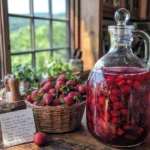Description
Ingredients
For this strawberry wine recipe, you’ll need:
- 4 pounds fresh strawberries (preferably ripe and in-season)
- 2 pounds granulated sugar
- 2 lemons, juiced and zested
- 1 orange, juiced and zested
- 1 gallon filtered water (chlorine-free)
- 1 package wine yeast (Champagne or Montrachet variety works best)
- 1 teaspoon yeast nutrient (available at brewing supply stores)
- 1 Campden tablet (optional, helps prevent spoilage)
Instructions
Step 1: Sanitize Your Equipment
First things first – the most important step in any fermentation project is cleanliness! Sanitize all equipment that will come in contact with your wine using a brewing sanitizer solution. This prevents unwanted bacteria from spoiling your batch.
This is something I learned the hard way when my first batch turned into strawberry vinegar instead of wine! Little Caleb actually still likes to dip his bagel in that mistake, so I guess it wasn’t a total loss.
Step 2: Prepare the Strawberries
Wash the strawberries thoroughly and remove the green tops. Place them in a large bowl and mash them well with a potato masher or clean hands until you’ve created a pulpy mixture. The more you break them down, the more flavor will be extracted.
I usually let Lila help with this part – she calls it “strawberry squishing” and considers it the most fun kitchen task ever. Just be prepared for red-stained little fingers!
Step 3: Create the Primary Fermentation Mixture
Transfer the mashed strawberries to a fine mesh straining bag and place in your sanitized fermenting bucket or carboy. In a large pot, bring half the water to a boil, then dissolve all the sugar into it, creating a simple syrup. Allow this syrup to cool to room temperature.
Once cooled, add the syrup to the fermenting vessel with the strawberries. Add the lemon juice, lemon zest, orange juice, and orange zest. The citrus adds necessary acidity and complexity to the wine.
Step 4: Add Remaining Water and Check Temperature
Add the remaining filtered water to bring the total volume to about one gallon, leaving a few inches of headspace in your fermenting vessel. Check the temperature of the mixture – it should be between 70-75°F (21-24°C) before adding the yeast.
Step 5: Prepare and Add the Yeast
Follow the instructions on your wine yeast package to activate it. Usually this involves rehydrating the yeast in a small amount of warm water for 15 minutes. Once activated, add the yeast and yeast nutrient to your fermenting vessel and stir gently.
Step 6: Begin Primary Fermentation
Secure your airlock (filled halfway with water or sanitizing solution) onto your fermenting vessel. If using a balloon as a makeshift airlock, place it over the opening of your container and prick 2-3 tiny holes in it with a sterilized pin.
Place the vessel in a dark, room-temperature location (68-75°F is ideal). Within 24-48 hours, you should see bubbling activity in the airlock, indicating fermentation has begun.
Step 7: Monitor Primary Fermentation
For the next 5-7 days, gently stir the mixture daily with a sanitized spoon, being careful not to splash (which can introduce oxygen). After stirring, always replace the airlock.
The primary fermentation is quite active – you’ll see bubbling and foam. This is when the yeast is happily consuming sugar and converting it to alcohol. It’s also when your kitchen will start to smell like a winery!
Step 8: Strain the Fruit
After 7-10 days, when the vigorous bubbling has slowed considerably, it’s time to remove the fruit. Using sanitized equipment, strain the liquid from the fruit pulp through your mesh bag or cheesecloth into a clean, sanitized secondary fermenting container.
This part can get messy – I recommend doing it over the sink or outside. The first time I did this, I ended up with strawberry splotches on my ceiling that took weeks to notice!
Step 9: Secondary Fermentation
Attach a clean airlock to your secondary fermenter and move it back to its dark, temperature-controlled location. The secondary fermentation is much less active but equally important – this is when the wine clears and develops its character.
Check the airlock occasionally to ensure it still has liquid and is functioning properly. You’ll notice the wine gradually becoming clearer as sediment falls to the bottom.
Step 10: Rack the Wine (Optional but Recommended)
After about 4-6 weeks in secondary fermentation, you may want to “rack” your wine – transfer it to a clean container, leaving the sediment behind. This improves clarity and flavor. To do this:
-
- Sanitize a new container and siphon tube
-
- Carefully siphon the wine from above the sediment layer
-
- Avoid disturbing the sediment as you transfer
-
- Re-seal with an airlock
You can repeat this racking process every few months if you wish for an exceptionally clear wine.
Step 11: Bottling
When your wine has cleared to your satisfaction (usually 3-6 months from the start), it’s time to bottle. Sanitize your bottles, siphon tube, and corks. Using the siphon, transfer the wine into bottles, leaving about 1.5 inches of space at the top.
Insert corks using a corking tool (you can rent these from brewing supply stores if you don’t want to purchase one). For a decorative touch, add shrink capsules or wax seals.
Step 12: Aging
While you can drink your strawberry wine young (after about 3 months total), it really develops wonderful complexity if you can wait 6-12 months. Store bottles on their sides in a cool, dark place.
Label your bottles with the date and perhaps a cute name – I call mine “Farmh
- Prep Time: 60 minutes
- Cook Time: 0 minutes
- Category: Beverage
- Method: Fermentation
- Cuisine: American
Nutrition
- Serving Size: 5 oz
- Calories: 135 per serving
Keywords: homemade strawberry wine recipe, fruit wine making, strawberry wine fermentation, easy strawberry wine, summer fruit wine recipe
